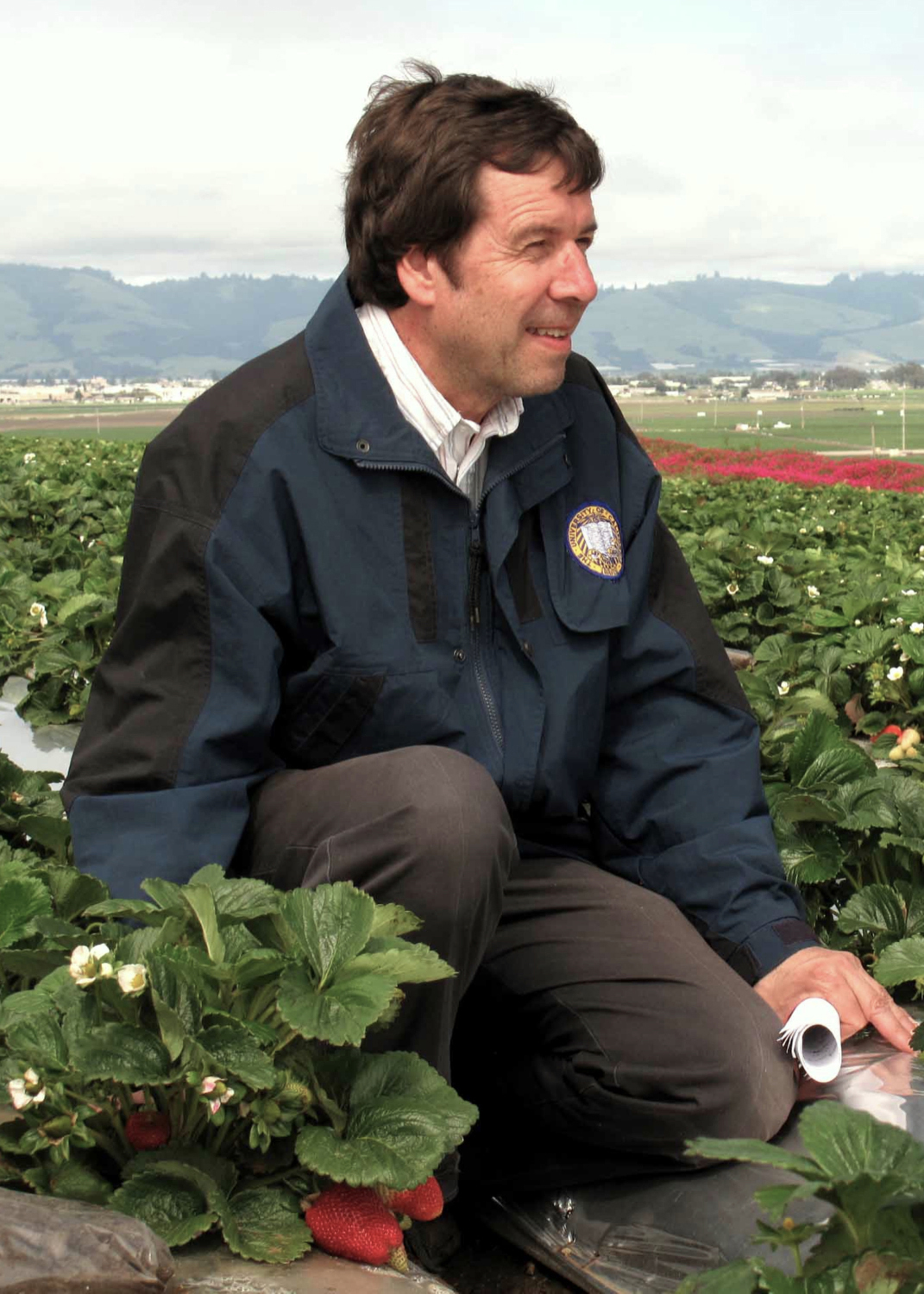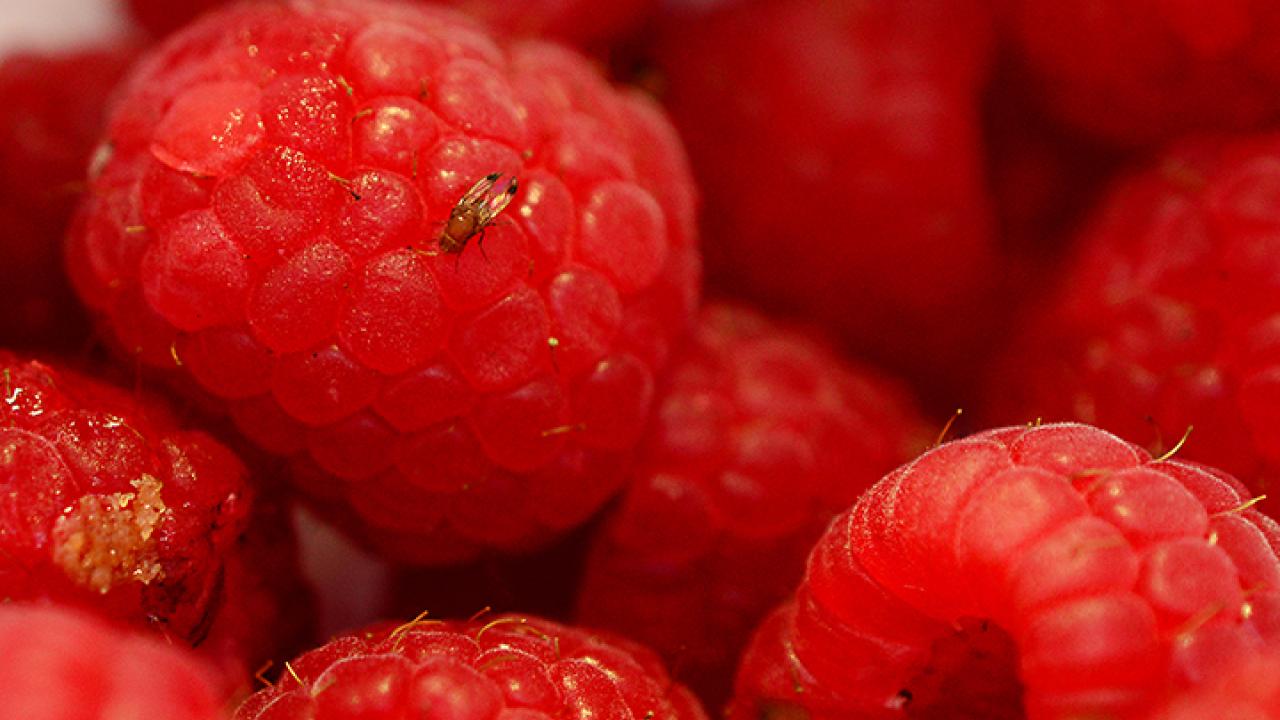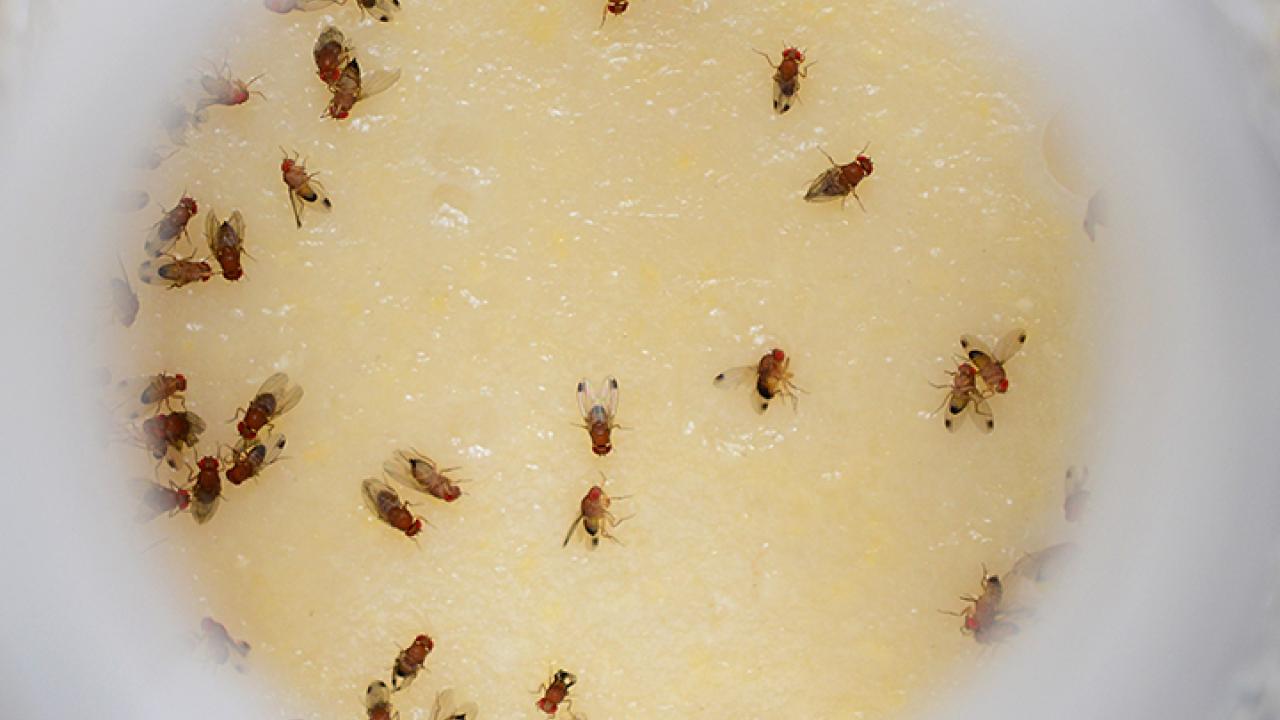
Zalom and Chiu Labs: Targeting the Spotted-Wing Drosophila
Christine Tabuloc of Chiu Lab Is Lead Author of Newly Published Paper
Quick Summary
- UC Davis First to Publish Paper Characterizing Molecular Mechanisms of Insecticide Resistance to Spotted-Wing Drosophila

Back in 2010, the UC Davis entomology labs of integrated pest management specialist Frank Zalom and molecular geneticist and physiologist Joanna Chiu joined forces to target the spotted-wing drosophila (SWD), a serious threat to berry production in California.
Drosophila suzukii, native to southeast Asia and first discovered in California in 2008, lays its eggs in such soft-skinned, ripening fruits as strawberries, raspberries, cherries, blueberries, peaches, nectarines, apricot and grape.
It packs a powerful economic impact. The first year of its discovery in California, the economic loss amounted to $500 million. Latest statistics from 2015 indicate a $700 million national economic loss.
The Zalom lab discovered the first SWD field populations with insecticide resistance in 2017. As the pest continues to spread throughout much of the country, anxious growers are worried about its increased resistance to pesticides.
The team’s newly published research in Scientific Reports is the first to characterize the molecular mechanisms of insecticide resistance in D. suzukii and provide insights into how current management practices can be optimized.

Lead author of the paper, “Transcriptome Analysis of Drosophila suzukii Reveals Molecular Mechanisms Conferring Pyrethroid and Spinosad Resistance,” is Christine Tabuloc, then a doctoral candidate and now a postdoctoral researcher working under the mentorship of Professors Chiu and Zalom.
"In this work, we leveraged high throughput sequencing to identify biomarkers of insecticide resistance in D. suzukii,” Tabuloc explained. “We found that different genes are responsible for resistance to different chemicals. Specifically, we found that genes involved in metabolism are highly expressed in flies resistant to pyrethroid insecticides. We also observed evidence of two different mechanisms of resistance in 2 lines generated from a single spinosad-resistant population. We found an increased expression of metabolic genes in one line and increased expression of cuticular genes in the other.”
“Therefore, we developed a diagnostic panel using these biomarker genes to differentiate between pyrethroid resistance and spinosad resistance,” Tabuloc related. “Not only can our assay now inform whether there is resistance, it can tell us which chemical the population is resistant to and how severe the resistance is. Additionally, this method is faster, enables for the testing of more populations, and is more comprehensive as compared to bioassays, the conventional way of testing for resistance.”
Tabuloc added that “our work has enabled for the detection of resistance in California populations, and we are currently doing a nationwide screening to determine whether resistance is now present in other states. Currently, we are working with the Zalom lab to use the results of our assays to try and combat resistance. There are experiments in progress trying to increase the efficacy of insecticides by blocking some of the genes involved in resistance, such that the enzymes encoded by those genes have decreased function."

Zalom, a UC Davis distinguished professor emeritus who directed the UC Statewide Integrated Pest Management Program for 16 years, said he has been “working on spotted-wing drosophila with Dr. Chiu and her lab members since she joined the UC Davis faculty in 2010, and it has been an absolute pleasure.”
Zalom, a past president of the 7000-member Entomological Society of America (ESA) and an elected Honorary Member, ESA’s highest honor, praised Chiu, a 2019-2024 Chancellor’s Fellow professor and now chair of the Department of Entomology and Nematology, as “one of the most collaborative researchers who I have ever worked with. When our lab found the first SWD field populations with insecticide resistance in 2017, it seemed obvious to ask Dr. Chiu about identifying the mechanism of resistance to different chemical classes and if it would be possible to develop a molecular diagnostic to confirm presence of insecticide resistance in field populations without conducting the time consuming and labor-intensive bioassays that we were using.”
“Dr. Chiu and her PhD student Christine Tabuloc took on this challenge and their work culminated in the description of genes associated with the resistance and the diagnostic assay presented in this paper,” Zalom said.
The Zalom lab “selected the SWD isolines from California field populations displaying resistance to pyrethroids and spinosyns after conducting bioassays on many hundreds of SWD adults, then helped Dr. Tabuloc validate results of the molecular assay,” he said.
“This work not only represents good science; it has very practical implications," Zalom said. "Dr. Tabuloc and I presented results of the work from both of our labs at a special berry grower seminar on insecticide resistance organized by UC Agriculture and Natural Resources (UC ANR) Farm Advisor Mark Bolda in Watsonville. The presentations were extremely well-received. The original program was targeted for about 1.5 hours, but the meeting extended to over three hours due to the extent of questions and great discussion that followed. Growers and their consultants are hungry for new information that they find interesting and potentially useful, and this work was clearly of interest to them.”

Bolda, strawberry and caneberry farm advisor in Santa Cruz, Monterey and San Benito counties, "was the first person who found the insect and asked me to come down to look at it and the problem," Zalom remembered. "That was 2008, and we weren’t able to get an actual species identification until 2009!"
Bolda noted that the recent berry grower meeting targeted SWD resistance on the Central Coast, with the UC Davis entomologists presenting. “The research was top shelf and the need, of course, is very great,” Bolda said. “Some of the information that Frank and Christine presented has been put into immediate use in the industry.”
“What made it really special was that since we were moving only a month or so later, and this was the last Extension meeting to be held at my UC Cooperative Extension Office,” Bolda said. “After 40 some years, that’s saying a lot and it was totally apropros that Frank, given his many, many years of service, was the very last to run a meeting there….and Christine presented also…she was really great and presented fabulous information.”
Among the “iconic individuals of Central Coast strawberries” who attended, Bolda said, was retired entomologist Ed Show (Driscoll Strawberry Association, Inc.) “who has been a part of strawberries since the 1970s.”

"It was nostalgic for me since it was the last meeting that was held there because they were moving to a new office," Zalom said. "I must have done 80 presentations at that auditorium over the years, including some of the very first ones that I did when returning to California when I was doing research on brussels sprouts and apples in that area."
Fruitville Collaboration. Professor Chiu said the publication “culminated years of fruitful collaboration and hard work by our lab and Professor Zalom’s lab, primarily driven by Christine…This research could not have been accomplished without Christine who is uniquely qualified to successfully lead the project; she combines her knowledge in insect genomics and bioinformatics with Drosophila molecular genetics.”
Chiu pointed out that “When the Zalom lab and my lab first started our collaboration in 2010, we were already worried about the potential development of insecticide resistance in D. suzukii given the primary method for management is insecticide application and the generation time of these flies are short. Unfortunately, this became a reality in 2017.”
“We hope that our research in developing more efficient molecular diagnostics to identify resistant populations will help prevent the spread of resistance to other U.S. states by allowing them to be proactive; perhaps to adjust their management program as soon as low level of resistance is detected,” Chiu said. “We are continuing to perform research to determine if resistance, once found, can be ‘weakened’ and what are mechanisms that could drive it. We think this will be very beneficial for growers in California, who currently have to tackle D. suzukiiwith insecticide resistance.”
Tabuloc, who joined the Chiu lab as an undergraduate research assistant in 2012, received her bachelor of science degree in biochemistry and molecular biology from UC Davis in 2015, and her doctorate from UC Davis in 2023.

In her doctoral exit seminar, in February 2023, Tabuloc detailed how she investigated the impact of insecticide applications on the fruit fly. "Specifically, I performed RNA sequencing analysis on D. suzukii flies that are either susceptible or resistant to common insecticides to determine genetic mechanisms underlying insecticide resistance in this agricultural pest. My results revealed that enhanced metabolic detoxification confers pyrethroid resistance while spinosad resistance is the result of both metabolic and penetration resistance. Finally, we identified alternative splicing as an additional mechanism of resistance. These results will facilitate the development of efficient molecular diagnostics to identify insecticide resistance in the field and enable growers to adjust D. suzukii spray programs to control this devastating pest more effectively."
In addition to Chiu, Zalom and Tabuloc, the 12-member team of researchers and co-authors included Curtis Carlson, Kyle Lewald, Sergio Hidalgo, Cindy Truong and Ching-Hsuan Chen, all from the Chiu lab; Nicole Nicola and Fatemeh Ganjisaffar of the Zalom lab; and Cera Jones and Ashfaq Sial of the Department of Entomology, University of Georgia, Athens. At the time, Truong and Chen were undergraduates, and Ganjisaffar was a postdoctoral fellow, and now a senior environmental scientist with the California Department of Food and Agriculture.
Federal and state grants awarded to Chiu and Zalom funded the project: a USDA National Institute of Food and Agriculture; and a California Department of Food and Agriculture Specialty Crop Block Grant. The team credits Bloomington Drosophila Stock Center for providing D. melanogaster stocks.
Resources:
Publication in Scientific Reports
UC IPM: Spotted-Wing Drosophila
Christine Tabuloc Exit Seminar
Frank Zalom: Honorary Member of ESA
Joanna Chiu: Outstanding Mentor
